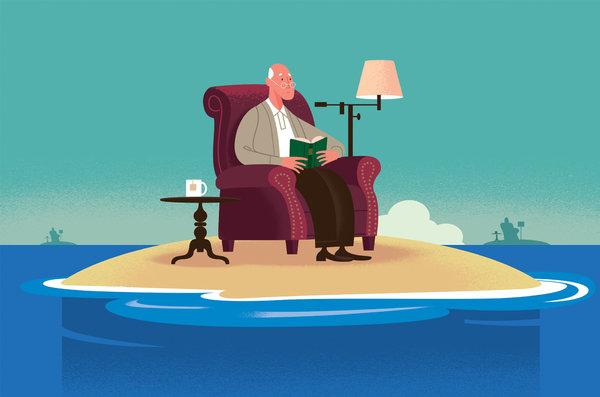Human beings are social creatures. Our connection to others enables us to survive and thrive. Yet, as we age, many of us are alone more often than when we were younger, leaving us vulnerable to social isolation and loneliness—and related health problems such as cognitive decline, depression, and heart disease. Fortunately, there are ways to counteract these negative effects.
NIA-supported researchers are studying the differences between social isolation and loneliness, their mechanisms and risk factors, and how to help people affected by these conditions. “NIA is interested in exploring potential interventions to address social isolation and loneliness, which are both risk factors for poor aging outcomes,” said Lisbeth Nielsen, Ph.D., of NIA’s Division of Behavioral and Social Research.
Social isolation and loneliness do not always go together. About 28 percent of older adults in the United States, or 13.8 million people, live alone, according to a report by the Administration for Community Living’s Administration on Aging of the U.S. Department of Health and Human Services, but many of them are not lonely or socially isolated. At the same time, some people feel lonely despite being surrounded by family and friends.
“A key scientific question is whether social isolation and loneliness are two independent processes affecting health differently, or whether loneliness provides a pathway for social isolation to affect health,” Dr. Nielsen noted.
Health effects of social isolation, loneliness
Research has linked social isolation and loneliness to higher risks for a variety of physical and mental conditions: high blood pressure, heart disease, obesity, a weakened immune system, anxiety, depression, cognitive decline, Alzheimer’s disease, and even death.
People who find themselves unexpectedly alone due to the death of a spouse or partner, separation from friends or family, retirement, loss of mobility, and lack of transportation are at particular risk.
Conversely, people who engage in meaningful, productive activities with others tend to live longer, boost their mood, and have a sense of purpose. These activities seem to help maintain their well-being and may improve their cognitive function, studies show.
Breaking ground in loneliness research
Much of what we know about the causes and effects of social isolation and loneliness comes from the groundbreaking research of the late John T. Cacioppo, Ph.D., former director of the Center for Cognitive and Social Neuroscience at the University of Chicago and an NIA grantee.
Dr. Cacioppo’s research found that being alone and loneliness are different but related. Social isolation is the objective physical separation from other people (living alone), while loneliness is the subjective distressed feeling of being alone or separated. It’s possible to feel lonely while among other people, and you can be alone yet not feel lonely.
A pioneer in the field of social neuroscience, Dr. Cacioppo passed away in March 2018. His wife and collaborator, Stephanie Cacioppo, Ph.D., continues this work as assistant professor of psychiatry and behavioral neuroscience at the University of Chicago and director of the university’s NIA-supported Brain Dynamics Laboratory.
“The misery and suffering caused by chronic loneliness are very real and warrant attention,” she said. “As a social species, we are accountable to help our lonely children, parents, neighbors, and even strangers in the same way we would treat ourselves. Treating loneliness is our collective responsibility.”
Although there is more to learn, the understanding of the mechanisms of action of loneliness and its treatment has increased dramatically since scientific investigation began more than two decades ago, according to Dr. Stephanie Cacioppo. Among the novel predictions from the Cacioppo Evolutionary Theory of Loneliness is that loneliness automatically triggers a set of related behavioral and biological processes that contribute to the association between loneliness and premature death in people of all ages. Research is headed toward the systematic study of these processes across generations, Dr. Cacioppo explained.
Understanding the biology of loneliness
Losing a sense of connection and community changes a person’s perception of the world. Someone experiencing chronic loneliness feels threatened and mistrustful of others, which activates a biological defense mechanism, according to Steve Cole, Ph.D., director of the Social Genomics Core Laboratory at the University of California, Los Angeles. His NIA-funded research focuses on understanding the physiological pathways of loneliness (the different ways that loneliness affects how your mind and body function) and developing social and psychological interventions to combat it.
For example, loneliness may alter the tendency of cells in the immune system to promote inflammation, which is necessary to help our bodies heal from injury, Dr. Cole said. But inflammation that lasts too long increases the risk of chronic diseases.
Loneliness acts as a fertilizer for other diseases,” Dr. Cole said. “The biology of loneliness can accelerate the buildup of plaque in arteries, help cancer cells grow and spread, and promote inflammation in the brain leading to Alzheimer’s disease. Loneliness promotes several different types of wear and tear on the body.
People who feel lonely may also have weakened immune cells that have trouble fighting off viruses, which makes them more vulnerable to some infectious diseases, he added.
NIA-supported research by Dr. Cole and others shows that having a sense of mission and purpose in life is linked to healthier immune cells. Helping others through caregiving or volunteering also helps people feel less lonely.
“Working for a social cause or purpose with others who share your values and are trusted partners puts you in contact with others and helps develop a greater sense of community,” he noted.
Researching genetic and social determinants of loneliness
In another NIA-funded study, researchers are trying to understand the differences between social isolation and loneliness and how they may influence health. They are also trying to identify potential interactions between genes and the environment of older adults affected by social isolation and loneliness.
Previous studies have estimated the heritability of loneliness between 37 percent and 55 percent using twins and family-based approaches. “Individuals who are not prone genetically to feeling lonely may, for example, suffer much less from social isolation, while others feel lonely even though they are surrounded and part of a rich social life,” according to Nancy Pedersen, Ph.D., a professor of genetic epidemiology at the Karolinska Institutet in Stockholm, Sweden. “We are also interested in understanding what role socioeconomic status plays in such associations.”
Using data from twin studies, Dr. Pedersen and researchers found that both social isolation and loneliness are independent risk factors, and that genetic risk for loneliness significantly predicted the presentation of cardiovascular, psychiatric (major depressive disorder), and metabolic traits. Family history does not strongly influence this effect.
“We need to identify people who are most prone to suffer from social isolation and loneliness and those who would benefit most from interventions,” said Dr. Pedersen. “Interventions for social isolation may look very different from interventions for those who feel lonely.”
Beyond genetics, understanding social determinants of health, and the role of social and interpersonal processes in healthy aging and longevity, is another research direction at NIH. Scientists are beginning to apply this framework to research on social isolation and loneliness.
“Future research will need to clarify the extent to which loneliness and social isolation are malleable, and if so, what are the most effective approaches? Demonstrating that we can move the needle on these risk factors is a critical first step toward developing effective interventions,” said Dr. Nielsen. Research is also needed to clarify how great a change in loneliness or social isolation is required to achieve a meaningful change in health, she added.

